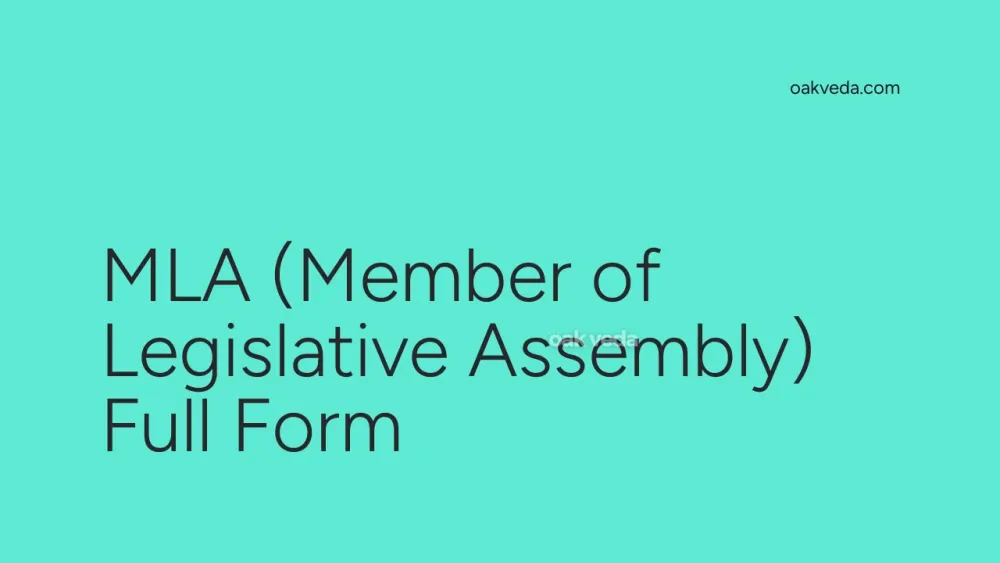
What is the Full Form of MLA?
The full form of MLA is Member of Legislative Assembly. In India, an MLA is an elected representative who serves in the state legislature, playing a crucial role in the country's democratic process at the state level.
What is a Member of Legislative Assembly?
A Member of Legislative Assembly (MLA) is an individual elected by the voters of a specific constituency to represent them in the state legislature. MLAs are integral to India's state-level governance, serving as a bridge between the people and the government.
Origin and Development of the MLA Position
The concept of MLAs in India can be traced back to the Government of India Act 1935, which introduced provincial legislatures. After India gained independence in 1947, the role of MLAs was further defined and strengthened within the framework of the Indian Constitution.
How does the MLA System Work?
The MLA system operates within India's federal structure:
- Each state is divided into constituencies
- Voters in each constituency elect their MLA
- The number of MLAs varies by state, based on population
- MLAs serve a term of five years, unless the assembly is dissolved earlier
Functions of MLAs
MLAs have several key responsibilities:
- Representing constituents: They voice the concerns and aspirations of their constituency in the state legislature.
- Legislation: MLAs participate in drafting, debating, and passing state laws.
- Budget approval: They review and approve the state budget.
- Government oversight: MLAs hold the state government accountable through questions and debates.
- Local development: They utilize the Local Area Development (LAD) fund to improve their constituency.
Applications of the MLA Role
MLAs apply their position in various ways:
- Policy-making: Influencing state policies to benefit their constituents
- Problem-solving: Addressing local issues and grievances
- Resource allocation: Ensuring fair distribution of resources to their constituency
- Social welfare: Implementing and monitoring welfare schemes
Features of the MLA Position
Key features of the MLA role include:
- Democratic representation: Directly elected by the people
- Legislative power: Ability to propose and vote on laws
- Executive oversight: Power to question the state government's actions
- Constituency focus: Dedicated to addressing local needs and development
Benefits of the MLA System
The MLA system offers several advantages:
- Local representation: Ensures each area has a voice in the state legislature
- Accessibility: Provides citizens with a point of contact for government-related issues
- Decentralized governance: Allows for state-specific policies and development
- Political training ground: Serves as a stepping stone for aspiring national leaders
Limitations or Challenges of the MLA System
Despite its benefits, the MLA system faces some challenges:
- Anti-defection law: Limits individual MLAs' ability to vote against party lines
- Money and muscle power: Can influence elections, potentially compromising representation
- Constituency limitations: MLAs may prioritize their constituency over state-wide concerns
- Workload: Balancing legislative duties with constituency work can be challenging
Future Developments in the MLA System
Potential future developments include:
- Digital engagement: Increasing use of technology to connect with constituents
- Transparency measures: Implementing stricter disclosure norms for MLAs
- Capacity building: Enhancing training and support for MLAs to improve their effectiveness
- Electoral reforms: Potential changes to the election process to ensure fair representation
FAQs on MLA Full Form
-
What are the essential requirements for becoming an MLA?
- Indian citizenship
- Minimum age of 25 years
- Registered as a voter in any constituency within the state
-
How many MLAs are there per MP in India? There are typically four to nine MLAs for every Member of Parliament (MP) in the Lok Sabha, depending on the state's population.
-
Can an MLA hold other positions in the government? Yes, an MLA can hold additional positions such as Chief Minister or Cabinet Minister.
-
What is the LAD fund mentioned in an MLA's duties? The Local Area Development (LAD) fund is a financial allocation provided to MLAs for development projects in their constituencies.
-
How long is an MLA's term? An MLA's term is typically five years, unless the state assembly is dissolved earlier.
-
What is the difference between an MLA and an MP? MLAs serve in state legislatures, while MPs (Members of Parliament) serve in the national parliament.
-
How do MLAs contribute to the legislative process? MLAs participate in debates, propose amendments, and vote on bills in the state legislature.
-
Can an MLA be removed from office before their term ends? Yes, an MLA can be disqualified under certain circumstances, such as violating the anti-defection law or being convicted of certain crimes.
In conclusion, the full form of MLA - Member of Legislative Assembly - represents a crucial role in India's democratic system. MLAs serve as the voice of their constituents in state legislatures, balancing local needs with state-wide concerns. While the system faces challenges, it remains an essential component of India's governance structure, continually evolving to meet the changing needs of the country's diverse population.
You may be interested in:
- CRISIL (Credit Rating Information Services of India Limited)
- CVC (Central Vigilance Commission) Full Form
- MRI (Magnetic Resonance Imaging): Full Form Explained
- DNA (Deoxyribonucleic Acid): Full Form and Explained
- AIDS (Acquired Immune Deficiency Syndrome)
- LED (Light Emitting Diode): Full Form and Applications

